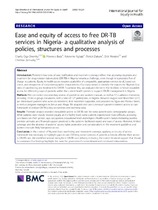| dc.identifier.citation | Oga-Omenka, Charity, et al. “Ease and Equity of Access to Free DR-TB Services in Nigeria- a Qualitative Analysis of Policies, Structures and Processes.” International Journal for Equity in Health, vol. 19, no. 1, BioMed Central Ltd, 2020, pp. 221–221, doi:10.1186/s12939-020-01342-w. | en_US |
| dc.description.abstract | Introduction: Persistent low rates of case notification and treatment coverage reflect that accessing diagnosis and
treatment for drug-resistant tuberculosis (DR-TB) in Nigeria remains a challenge, even though it is provided free of
charge to patients. Equity in health access requires availability of comparable, appropriate services to all, based on
needs, and irrespective of socio-demographic characteristics. Our study aimed to identify the reasons for Nigeria’s low
rates of case-finding and treatment for DR-TB. To achieve this, we analyzed elements that facilitate or hinder equitable
access for different groups of patients within the current health system to support DR-TB management in Nigeria.
Methods: We conducted documentary review of guidelines and workers manuals, as well as 57 qualitative interviews,
including 10 focus group discussions, with a total of 127 participants, in Nigeria. Between August and November 2017,
we interviewed patients who were on treatment, their treatment supporter, and providers in Ogun and Plateau States,
as well as program managers in Benue and Abuja. We adapted and used Levesque’s patient-centered access to care
framework to analyze DR-TB policy documents and interview data.
Results: Thematic analysis revealed inequitable access to DR-TB care for some patient socio-demographic groups.
While patients were mostly treated equally at the facility level, some patients experienced more difficulty accessing
care based on their gender, age, occupation, educational level and religion. Health system factors including positive
provider attitudes and financial support provided to the patients facilitated equity and ease of access. However, limited
coverage and the absence of patients’ access rights protection and considerations in the treatment guidelines and
workers manuals likely hampered access.
Conclusion: In the context of Nigeria’s low case-finding and treatment coverage, applying an equity of access
framework was necessary to highlight gaps in care. Differing social contexts of patients adversely affected their access
to DR-TB care. We identified several strengths in DR-TB care delivery, including the current financial support that should
be sustained. Our findings highlight the need for government’s commitment and continued interventions. | en_US |

